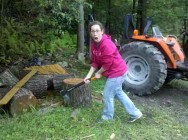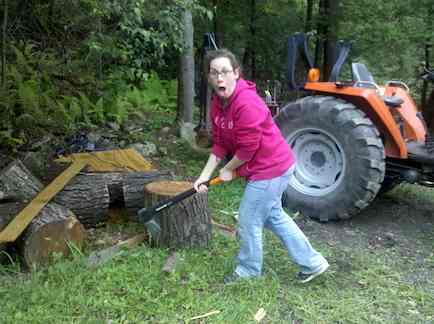Living in a tree stump – past and present
https://www.off-grid
Auto Amazon Links: No products found.
https://www.off-grid
Auto Amazon Links: No products found.


Assuming you have access to a source of wood – your own or someone else’s – some basic questions you should ask yourself before cutting are:
. Which trees should I cut?
. When is a good time to cut the trees?
. Should I dry, then split, or split the wood first?
. Will I ruin my woods/lot by cutting out trees for firewood?
Before you begin the firewood process, think about all you want from your woods/lot. Cutting firewood works for most owners, but where some trees might be good choices to cut for firewood, others might be left for use by wildlife, or to keep for landscaping or property value reasons.
When you inspect your trees for firewood, you should look for trees with evidence of disease, like cankers, bleeding lesions, and dieback in the crown. Crooked or densely arranged hardwoods often benefit by thinning, and make good firewood.
The trees selected to remain standing, should be clearly marked as “keepers” to help you monitor your progress as a property owner. You might want to take a closer look at trees that are acting as a wind-break, or as a stream or hillside soil retainer. Consult with a forester or arborist to determine if certain trees have a greater value left standing than as firewood.
Plan your firewood removal process to maximize chainsaw safety by planning out which trees to cut first, and to provide room to fell other trees afterward. If you decide to do this yourself, you should work with a partner and keep each other in clear communication and visual contact, to prevent accidents.
Trees with crown dieback may drop major limbs during the cutting process. It is also advised to check and mark trees in the late spring where you can easily see the dead branches against the green emerging leaves.
Also, before you start, you should consult with the city, county or subdivision codes/regulations to make sure that you are not on a variance or there is some other restriction. Checking with utility companies if any poles or lines are in the area is also a highly advisable.
Remember to look up first before you cut. Many trees grown close to, or may fall on electrical or telephone wires and cause serious damage to your property or neighbors. Along these same lines, check and make sure a tree will not fall on fences, water tanks/troughs, outbuildings, etc. before you cut. If any of these situations are present, you should consult or hire a professional.
Indoor wood stoves/fireplaces should be supplied with only fully seasoned hardwoods like sugar and red …

Interview with Val Kilmer in his tree-house.
Auto Amazon Links: No products found.
2023 © Off-Grid.net
9b Audrey St. London E2 8QH
email news@off-grid.net
call US office: toll-free 1-877-706-7423
OR
UK: +44 207 729 2749
How to register – Coming Soon
How to Manage your off-grid account
How to use the off-grid map – Coming Soon
Coming Soon
